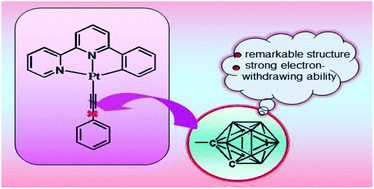Carboranes have attracted increasing interest in the scientific community due to their remarkable structures and strong electron-withdrawing abilities. In this article, four platinum complexes [(C^N^N)PtC![[triple bond, length as m-dash]](http://www.rsc.org/images/entities/char_e002.gif) CPh](1), [(C^N^N)PtC
CPh](1), [(C^N^N)PtC![[triple bond, length as m-dash]](http://www.rsc.org/images/entities/char_e002.gif) C-TPA](2), [(C^N^N)PtC
C-TPA](2), [(C^N^N)PtC![[triple bond, length as m-dash]](http://www.rsc.org/images/entities/char_e002.gif) C-TAB](3), [(C^N^N)PtC
C-TAB](3), [(C^N^N)PtC![[triple bond, length as m-dash]](http://www.rsc.org/images/entities/char_e002.gif) C-CB](4) (where TPA = triphenylamine, TAB = triarylboryl, CB = o-carborane) have been calculated via density functional theory (DFT) and time-dependent density functional theory (TDDFT) methods to mainly explore the influence of carborane substituents on electronic structures, photophysical properties and radiative decay processes. The calculated results reveal that 2 with electron-donating triphenylamine has a low radiative decay rate constant and a red-shifted emission band, but 3 and 4 containing electron-withdrawing triarylboryl and o-carborane exhibit the opposite properties, especially 4 is supposed to have the highest phosphorescence quantum yield with the smallest nonradiative decay rate constant. These findings successfully illustrated the structure–property relationship and the designed complex 4 with carborane can serve as a highly efficient phosphorescent material in the future.
C-CB](4) (where TPA = triphenylamine, TAB = triarylboryl, CB = o-carborane) have been calculated via density functional theory (DFT) and time-dependent density functional theory (TDDFT) methods to mainly explore the influence of carborane substituents on electronic structures, photophysical properties and radiative decay processes. The calculated results reveal that 2 with electron-donating triphenylamine has a low radiative decay rate constant and a red-shifted emission band, but 3 and 4 containing electron-withdrawing triarylboryl and o-carborane exhibit the opposite properties, especially 4 is supposed to have the highest phosphorescence quantum yield with the smallest nonradiative decay rate constant. These findings successfully illustrated the structure–property relationship and the designed complex 4 with carborane can serve as a highly efficient phosphorescent material in the future.

